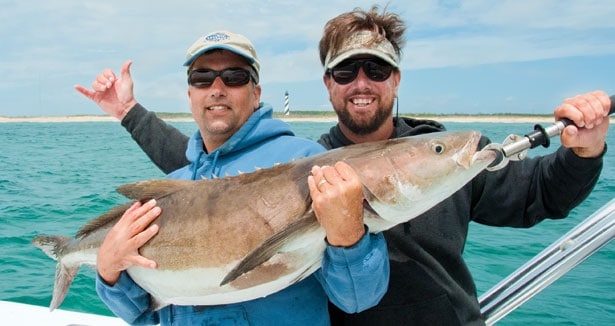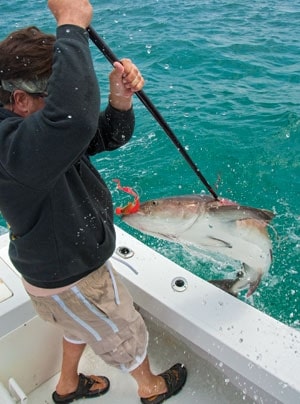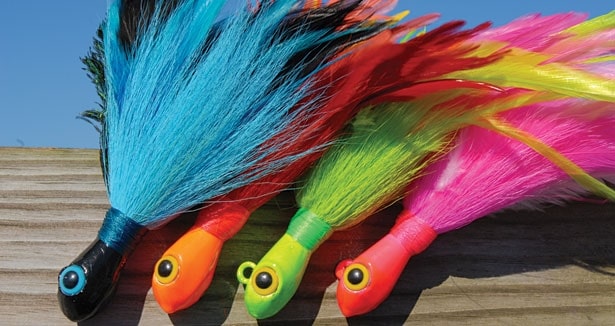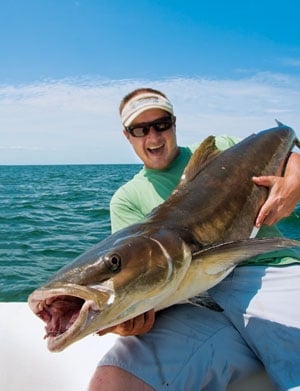
After hours perched on the bow of my 20-foot center-console under a scorching sun, my brain had baked like a potpie. My vision blurred and my skin was burnt to a crisp.
As we slowly motored around the ocean, the calm, green water and the clear, blue sky melted into one stifling-hot expanse of emptiness. So when I spotted a long, brown fish swimming just under the surface, I shook my head and blinked my eyes. A second look confirmed the sighting.
“COBIA! COBIA! COBIA!” I yelled to my brother, Roger, who was at the helm.
He whispered: “Where? Where? Where?” as if his voice would spook the fish we had been searching for all day.
I pointed at the brown bomber and hollered again: “COBIA! COBIA! COBIA!”
Southern Start
The mid-Atlantic cobia fishing craze started a dozen years ago off North Carolina’s Outer Banks; local captain Aaron Kelly (252-441-6575, www.rocksolidfishing.com) was one of the first skippers to make sight-casting his business. Late last May, I joined Kelly for a day on the water and a lesson on sight-casting. We met at Oregon Inlet Fishing Center late in the morning; Kelly was carrying a handful of heavy spinning rods and a bucketful of slithering live eels. A few minutes later, his crew of three sharpshooters arrived. We boarded Kelly’s 27-foot center-console, and left the marina under bright skies and light winds.
Once out in the open Atlantic, Kelly climbed his three-story tower and strapped into the crow’s nest. Without electronics in the tower, Kelly armed himself with a laser-guided temperature gun in one hand and a big spinning rod in the other. He instructed one of the crew to point the boat south and give it gas.
As we passed Pea Island and Rodanthe Village, Kelly called off water-temperature readings: 65, 66, 67 degrees. When the water hit 68, we slowed and started looking for signs of fish. Kelly says cobia prefer water between 68 and 73.5 degrees. He looks for fish from the mouth of Oregon Inlet to Diamond Shoals and from the surf line out to Whimble Shoals. Wrecks, reefs, tide lines, and even big rays and turtles can all host cobia, but most times the fish cruise out in the open.
We weaved our way south within a few miles of the beach, all eyes scanning the surface, while Kelly continued to test the water temperature. By the time we had worked our way to the iconic candy-striped Hatteras Lighthouse, the ocean was crystal clear and 72 degrees.
“There’s one,” Kelly yelled from his crow’s nest. A few seconds passed before my eyes found the big brown fish, which was 50 yards off and steadily moving toward the boat. The driver took the single diesel out of gear. The angler on the bow made a perfect cast that landed his bucktail right in front of the fish.
But the cobia spooked and my hopes dashed, until Kelly yelled, “There he is!” and pointed to the fish, which was now hiding on the bottom about 20 feet below. “Drop your bucktail and jig it,” Kelly commanded. The guy with the rod opened the bail and let the bucktail fall. We watched the bright-orange lure descend until it was lying next to what looked like a heavy log. The log shot forward and the angler’s line came tight. “That’s how it’s done!” Kelly yelled.
After we landed the fish and everyone had climbed back onto the tower, Kelly described to me exactly how it is done.
Irresistible Attraction
“Boat speed is critical,” he started, explaining that every boat’s engine makes different sounds and sends out different vibrations at different speeds. Each captain must experiment to find what works with his boat. “Get the pitch of the motor right, and they will come to you.”
If the fish isn’t on a collision course, Kelly turns to intercept it at an angle. “The worst thing is to T-bone one,” he said. “Don’t take the engine out of gear or change speed.”
Kelly keeps one angler ready with a live eel and another with a bucktail. When the boat passes within 25 yards of the fish, he instructs his first angler to cast. “I start with the eel, then follow up with a bucktail,” he said. If a cobia doesn’t react to those first casts, Kelly shows the fish something different. “You can throw a spot at them,” he said, “or a croaker, bluefish, mullet – I’ve even caught cobia on an oyster toad.”
After a cobia takes the bait. Kelly immediately motors away from the fish. “You’ve got to set the hook and keep tension on the fish,” he explained. “A lot of guys try to fight fish from a dead boat.”
If a cobia spooks, Kelly keeps his eyes open. “A lot of times the fish will pop up again heading in the same direction. Keep an eye out the back of the boat too. A lot of times they’ll sneak up behind you.”
For Kelly, perfect cobia conditions include the presence of bait, decent water clarity and light current. “Find a temperature break or an area of dead current around Cape Point [off Cape Hatteras],” he said, “and you’ll find fish.” The perfect cobia day would also feature a 10 to 15 mph southwest wind. “That puts the wind and current in the same direction, which pushes fish to the surface.”
Even on a less-than-perfect day, Kelly can still catch cobia. “We’ve had days when we caught 30 fish in the wind and rain,” he said. When the sky is overcast, he’ll throw out a block of menhaden chum and wait for the fish to come to him.
Kelly chases cobia from early May through the middle of September, but by June, most of the fish have moved to Chesapeake Bay. That’s where I picked up the chase in early June with Capt. Ben Shepard (757-621-5094, www.aboveaveragesportfishing.com), one of the first skippers to bring sight-casting to Virginia.
Traditionally, the state’s anglers anchored to chum for cobia, which attracts everything from car-hood rays to scrappy sharks. But several years ago, Shepard learned the sight-fishing technique in Florida and unleashed it at home.

Virgin Waters
“We’ll meet at 10 o’clock,” Shepard told me over the phone. “What time?” I asked incredulously. “Ten,” he repeated, “no hurry.” I agreed but still arrived early to Bubba’s Marina in Virginia Beach. Shepard and his buddy Jason Legg already had Shepard’s bay boat in the water and ready to go. By the time we left Lynnhaven Inlet, the sun was high and the air still and hot: perfect conditions for spotting cobia.
We didn’t run far. Shepard headed toward Chesapeake Bay Bridge Tunnel, the 17-mile-long span that crosses the mouth of bay, and continued up Thimble Shoal toward Norfolk. About a mile north of the bridge, we stopped in the middle of nowhere and started looking for brown suits. We didn’t look long.
“Cobia,” Shepard announced. I searched the water with my inferior eyes and finally saw the fish cruising 50 yards off the bow.
Anxious, I prepared to throw a live eel with a spinning rod. Shepard stopped me. “That’s just a little fish,” he said. “Use this.” He handed me a lighter rod with a ounce plain, yellow bucktail jig.
The rod’s whippy tip allowed me to land the light lure close enough to get the small cobia’s attention. I retrieved the small jig across the surface, and the cobia went absolutely nuts – turning, swiping, slashing and annihilating the little lure.
After we landed and released the 30-pound fish, Shepard explained that he’d caught cobia of all sizes on the small, yellow jig. “I don’t know what they think it is,” he admitted, “but cobia can’t stand that thing.”

For bigger fish, he uses a 2- to 3-ounce bucktail. “You want a lot of hair and a big rubber tail so the bucktail sinks slower,” he said.
Like Kelly, Shepard first throws the eel. “A perfect cast lands five feet from the fish’s head,” Shepard says. When the cobia bites, he instructs his angler to open the bail and let the cobia take the bait for a couple of seconds. Then close the bail and let the line come tight.
“When you throw the bucktail, jig it fast and hard,” he says. Shepard has noticed that each cobia reacts differently to the jig. “If they’re not super interested, slow it down,” he suggests, “do something different.”
Stock of the Bay
With Shepard’s instructions running around in my head, we continued north up Thimble Channel. Shepard told me the fish first show in late May along Thimble Shoal or Baltimore Channel. “From year to year, they seem to prefer one over the other,” he pointed out.
Water temperature plays a key role in finding cobia, he says. A pocket of water that’s cooler or warmer than the surrounding bay can hold fish. Look for any inconsistencies such as tide lines, floating debris or color changes. Shepard also prefers at least a little current.
By June, the fish spread out in the open bay. “We just cruise around looking for fins,” he says, which is exactly what we did that early June day.
After we tooled up Thimble Shoal Channel, Shepard changed course and headed northeast across Horseshoe Shoal. Almost as soon as we hit the edge of Baltimore Channel, we saw another fish. Shepard pointed toward a raft of small, purple jellyfish that was formed by the edge of a tide line. This cobia was bigger.
Jason Legg took the cast, landing the eel a few feet from the fish’s head. The squirming worm sank slowly. As expected, the big cobia didn’t let the eel get far. Legg came tight on the line and the fight erupted.
The fish ran and bulldogged then jumped twice, struggling to get its fat, brown body out of the water. Once the fish had spent its considerable energy, Shepard gaffed the 60-pounder and dispatched it with an aluminum billy club to keep the cobia from wreaking havoc on deck.
World-Class Cobia
With the fish photographed and stored in the fish box, we climbed back into the bay boat’s tower, and Shepard continued to tell me about cobia fishing in the bay. “Later in the summer, cobia home in on any structure in the lower bay, from bridge pilings, rocks, buoys, to tide lines and temperature breaks,” he said.
Toward the end of September, cobia leave the bay, and anglers find some amazing action along Virginia Beach’s oceanfront on buoys and tide lines. Shepard said he sees schools of 10 to 50 fish; once he saw a pod with at least 300 cobia.
Shepard and Kelly have recorded outstanding catches from the Outer Banks to Virginia. Each averages 200 to 250 cobia in a season. Last year, Shepard lost count at 400 and Kelly set a personal record with 300. On Shepard’s best day in the bay, he caught 19, but last spring he was in on an unprecedented run of cobia off Hatteras – scoring more than 40 cobia in one day.
Kelly’s best-ever day came on his first day cobia fishing last spring. “We got to the Hook (inside Cape Point) at 7 a.m., and we were in the meat,” he told me, excitement from the day’s adventure still vibrating in his voice. “I looked to my left and saw 20, then to the right and saw another 15. There were singles, doubles, triples; they were all balled up. It was game on. We started whacking them.”
So many fish and only two anglers. Faced with the chance to have an epic day, Kelly knew he needed help. He called one of his most obsessed clients, and the guy drove down to the beach and swam out to Kelly’s boat. The three anglers worked like machines casting, hooking, fighting, unhooking, and casting again until they had caught and released 72 cobia. “I’d never seen anything close to that ever,” he reflected.
With cobia fishing improving each year, anglers visiting the Outer Banks and Chesapeake Bay have a shot of seeing something truly special. “Drive around looking for cobia,” Shepard said, “and you won’t believe your eyes.”

Tackle Up
Sight-casting for cobia might be the simplest fishing experience ever conceived. “Just drive around all day and look for fish,” Virginia Capt. Ben Shepard says. Rigging for these fish is easy too.
Two outfits cover all your cobia needs: a heavy-action spinning rod with a stiff tip for casting a bucktail, and a lighter stick with a slower bend to toss an eel. Both rods should measure at least 7 feet; reels should hold enough 50-pound braid and generate enough drag to tire a 100-pound cobia.
To rig the bucktail rod, use a Bimini/Albright connection to double the main line, and attach 3 feet of 60-pound fluorocarbon and a brightly colored 2- to 3-ounce bucktail. To the jig hook, add a rubber twister tail in pink, orange, chartreuse or white; the tail prevents the jig from falling too fast. For the lighter rod, use the same length of 40-pound fluoro and an 8/0 Gamakatsu Octopus Circle hook.
When Shepard encounters small cobia, he chooses a medium-action spinner that’s limber enough to throw a 1/8-ounce bucktail.
Cloudy skies don’t keep cobia enthusiasts off the water: When the sun hides, Shepard and North Carolina Capt. Aaron Kelly break out a block of menhaden chum and drift their live eels through known cobia hangouts.








